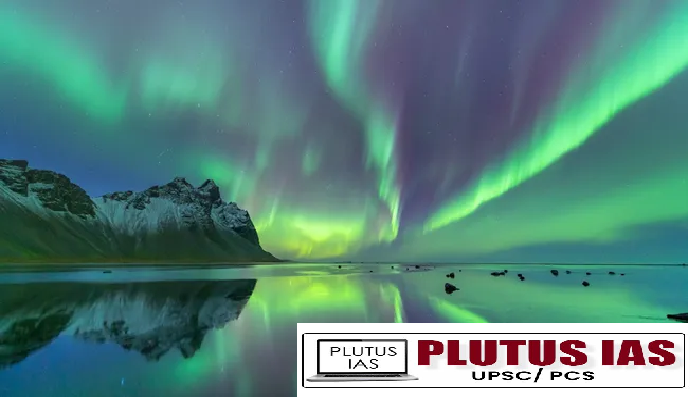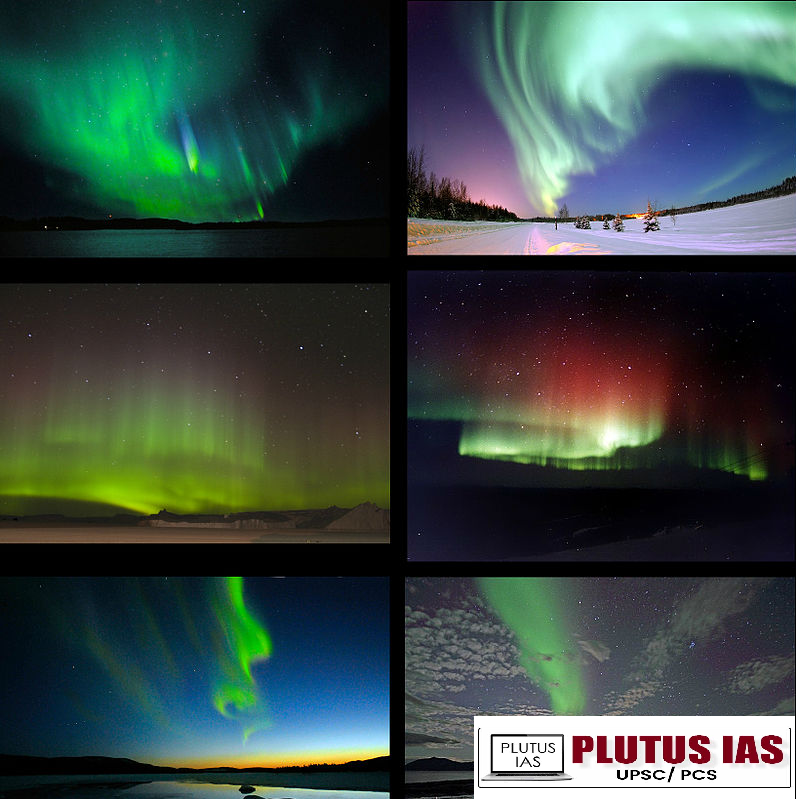12 Oct Chasing the Northern Lights: A Journey into the Aurora Borealis
SYLLABUS MAPPING:
GS-1- Important Geophysical Phenomenon–Chasing the Northern Lights: A Journey into the Aurora Borealis
FOR PRELIMS:
Compare and contrast the Aurora Borealis with its Southern Hemisphere counterpart, the Aurora Australis. What are the similarities and differences in their formation and visibility?
FOR MAINS:
Investigate the psychological and emotional effects that witnessing the Aurora Borealis can have on individuals. What are some documented responses to this natural phenomenon?
Why In the News?
Recently, Auroras, which are typically visible in high-latitude regions such as the North and South Poles, have been observed worldwide, including in areas where they are uncommon. In India, they were observed through all-sky cameras positioned around the Indian Astronomical Observatory (IAO) in Hanle, Ladakh.
What is the Aurora Phenomenon?
Auroras are bright and colourful lights formed due to an active interaction in Space between charged solar winds and the Earth’s magnetosphere. They occur when violent solar events eject charged particles into space, which become trapped in Earth’s magnetic field and interact with atmospheric atoms, ultimately resulting in geomagnetic storms and the creation of aurora.
The constantly changing inputs from the sun, the varying responses from the Earth’s upper atmosphere, and the motion of the planet and particles in near-Earth space all work together to create different auroral motions and shapes. The phenomenon in the Northern Hemisphere is called the Northern Lights (aurora borealis); in the Southern Hemisphere, it’s called the Southern Lights (aurora australis).

Mechanism of Aurora Borealis:
Aurora Borealis in India:
Best Time: October to March, when the skies are clear and the nights are long.
2. Kashmir: Known for its breathtaking landscapes, areas in Kashmir, especially around Gulmarg and Pahalgam, provide opportunities for clear night skies.
Best Time: Winter months are ideal for clearer visibility.
3. Nubra Valley: Located in Ladakh, Nubra Valley offers stunning views and minimal light pollution, making it an excellent location for stargazing.
Best Time: Summer months, especially during clear nights.
4. Mount Abu: Mount Abu has relatively clear skies as the only hill station in Rajasthan. While Auroras are not visible, the stargazing experience can still be rewarding.
Best Time: October to March.
5. Rann of Kutch: The white salt desert of Kutch in Gujarat offers unique night skies, especially during the Rann Utsav festival, which attracts many tourists for its cultural performances and clear skies.
Best Time: November to February.
Significance of Aurora Borealis:
1. Solar-Earth Connection: Provides insights into the interaction between solar winds and Earth’s magnetic field.
2. Atmospheric Studies: Helps researchers understand atmospheric composition and dynamics at high altitudes.
3. Space Weather Monitoring: Acts as a natural indicator of space weather events, aiding in forecasting potential impacts on satellite and communication systems.
4. Indigenous Lore: Holds cultural importance in many indigenous Arctic communities, often featured in folklore and mythology.
5. Inspiration: Inspires art, literature, and scientific exploration, reflecting humanity’s fascination with nature.
Ecosystem Impact: Affects local ecosystems by influencing weather patterns and animal behaviours in polar regions.
6. Climate Change Indicators: Changes in auroral activity may signal climate and atmospheric conditions shifts.
7. Tourism Attraction: Drives eco-tourism in regions like Norway, Iceland, and Canada, boosting local economies.
8. Educational Opportunities: Provides unique learning experiences for tourists and researchers, promoting awareness of atmospheric science.
9. Emotional Impact: Witnessing the aurora can evoke feelings of awe and wonder, contributing to mental well-being and a deeper appreciation for nature.
Effects:
1. Auroras affect communication lines, radio lines and power lines.
2. It should also be noted here that the Sun’s energy, in the form of solar wind, is behind the whole process.

Conclusion:
Chasing the Northern Lights is not merely about witnessing a natural phenomenon; it’s a journey into the heart of our planet’s beauty and complexity. The science behind the Aurora Borealis and its cultural significance and environmental considerations create a rich tapestry of experiences for those fortunate enough to embark on this adventure. Whether standing under the vivid lights in a remote Arctic landscape or learning about its wonders from a knowledgeable guide, the Aurora Borealis offers a profound reminder of the mysteries of our universe and the beauty of the natural world.
Download plutus ias current affairs eng med 12th Oct 2024
Prelims Question:
Q. Consider the following statements: (2018)
1. The Earth’s magnetic field has reversed every few hundred thousand years.
2. When the Earth was created more than 4000 million years ago, there was 54% oxygen and no carbon dioxide.
3. When living organisms originated, they modified the Earth’s early atmosphere.
Which of the statements given above is/are correct?
A. 1 only
B. 2 and 3 only
C. 1 and 3 only
D. 1, 2 and 3
Answer: C
Mains Question:
Q. Critically assess the environmental and economic implications of increasing tourism focused on the Aurora Borealis. What measures can be taken to promote sustainable tourism in these regions? (250 words, 15 marks)




No Comments